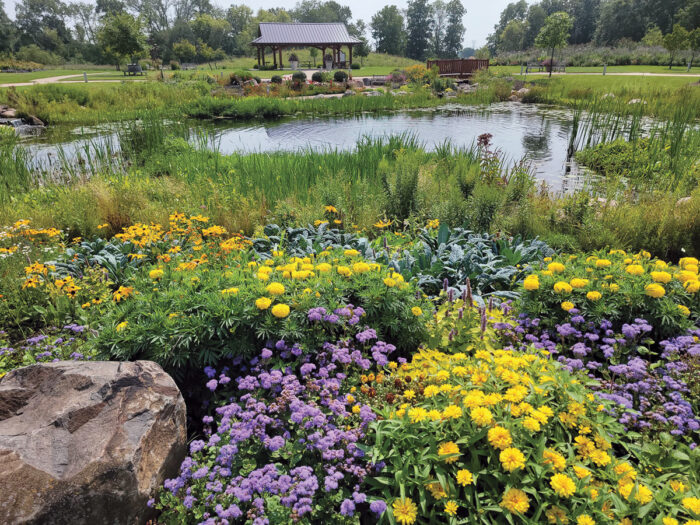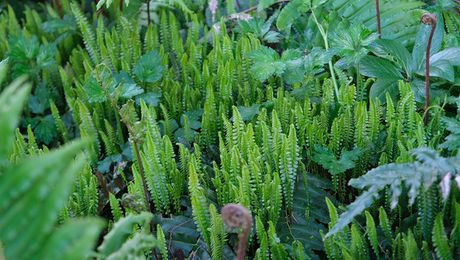
A garden space that encourages sensory engagement and contact with nature can inspire feelings of familiarity, comfort, positive distraction, and security. Simply stated, we feel better when we’re outdoors. Studies have shown that within just a few minutes of garden immersion, stress levels and blood pressure decrease significantly.
The value of making a personal connection with nature has been a central theme in my work as garden manager for the Edgerton Hospital Healing Garden in southern Wisconsin. I designed this 3-acre space in conjunction with the construction of the hospital to support the personal wellness of patients, staff, visitors, and the general public. Whether through beautiful views from recovery rooms or more active immersion through therapy activities, yoga, Tai Chi, or family visits, the healing garden offers abundant opportunities for reflection and relaxation. And although this garden is larger than some home landscapes, it includes many features and ideas that can easily be adapted to smaller, more intimate settings.

Let layout and function provide a framework for your planning process
Before selecting plants, think about what you’d like the experience of moving through the garden to feel like. Pathways with accessible surfaces will provide gentle guidance to the garden visitor, but where are they headed? Make the ease of entering and exiting the space a primary consideration, and be sure to create some destinations and focal points in spots that feel embraced by the garden.
Paths, decks, and patios should all be easy to safely navigate for every visitor. Incorporate resting spots and reflection nooks with comfortable seating options and beautiful views. If mobility challenges are a consideration, raised beds can be used to put plants at a more accessible height. Tasteful garden lighting will add nighttime and seasonal interest. As you plan garden features, think about the views from indoors. Putting together a conceptual sketch that considers where focal points will be and how foot traffic will flow is a good exercise for assessing how the space will function.
Shade provided by plants or structures enhances the appeal of any destination designed for resting, contemplation, or congregation. People naturally gravitate to a shaded back porch, patio, or seating area, and garden structures like arbors, gazebos, or pavilions can provide shelter from wind and rain. Site trees strategically to create shading within the garden or to keep intense morning or afternoon sun from flooding through windows that face east or west.
An immersive experience engages all the senses
Visual beauty and delicious food are garden bounties we often take for granted, but touch, scent, and sound greatly enhance time spent outdoors. As your design evolves, think about ways to enrich the visitor’s experience through each of the five senses.
For example, a well-timed progression of flowering bulbs, woody plants, and perennials can be selected to provide seasonal fragrance from spring through fall. Site scented plants close to pathways, windows, and gathering areas to ensure maximum enjoyment. Include plants with scents that are released through touch, flowers with fragrances that waft through the air, and plants that are most aromatic in the evening. In the hospital healing garden, we label many scented plants with signage to encourage interaction. These include herbs of all kinds, scented geraniums (Pelargonium cvs., Zones 10–11), chocolate cosmos (Cosmos atrosanguineus, Zones 7–9), and fragrant pinks (Dianthus spp. and cvs., Zones 4–9).

You will enhance the meditative qualities of any garden by mitigating distracting outside noises. Can you use screening or other landscape features to minimize sounds from neighbors or a nearby road? A well-positioned and carefully maintained water feature offers amazing auditory and tactile feedback, while the soothing music of moving water masks undesirable noise.
Most gardens are not designed with tactile engagement in mind, but putting a wide range of plant materials within reach of visitors will greatly enhance the sensory experience. Elevated containers can be used to put plants with touchable textures at a height that is accessible to everyone, including children and people who use wheelchairs.

Planting combinations throughout your garden will support the goal of restoration by offering beauty, sensory engagement, and wildlife value. Keep seasonal interest in mind as you create spaces that evoke a feeling of personal sanctuary. Plants that attract wildlife will also contribute tremendous energy and interest to your verdant, restorative design. Choose varieties that are well-suited to your site’s unique growing conditions, and combine them into an evolving tapestry that defines garden rooms.
Any landscape can become a refuge of well-being, and each should be designed to address the specific needs of the visitors who will spend time there. Combining an intentional layout of circulation and resting areas with an immersive planting design can be the foundation for a restorative garden that provides a rich sensory experience.

Mark Dwyer is the garden manager for the Edgerton Hospital Healing Garden in Edgerton, Wisconsin. He is also a Midwest regional reporter and forum moderator at FineGardening.com.
Fine Gardening Recommended Products

SHOWA Atlas 370B Nitrile Palm Coating Gloves, Black, Medium (Pack of 12 Pairs)
Fine Gardening receives a commission for items purchased through links on this site, including Amazon Associates and other affiliate advertising programs.

Planting in a Post-Wild World: Designing Plant Communities for Resilient Landscapes
Fine Gardening receives a commission for items purchased through links on this site, including Amazon Associates and other affiliate advertising programs.

Gardener's Log Book from NYBG
Fine Gardening receives a commission for items purchased through links on this site, including Amazon Associates and other affiliate advertising programs.





















Comments
Log in or create an account to post a comment.
Sign up Log in